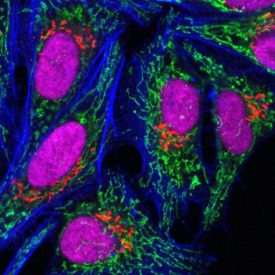Content #1
Content #1
Content #1
Unwanted protein aggregation can cause major problems in the food and pharmaceutical industries. Protein fouling, caused by protein aggregation, can lead to loses of billions of dollars in the food industry. Also, the presence of protein aggregates in pharmaceutical drug products can affect product stability, safety and efficacy.
In the dairy industry, heat treatment (~140 °C for 4-10 seconds) of milk is used to extend shelf-life, but this treatment affects the properties of milk products, such as stability, due to aggregation of milk proteins like β-lactoglobulin (β-Lg) and κ-casein (κ-CN). Protein misfolding and aggregation can lead to the formation of amyloid fibrils, long unbranched fibers composed of β-sheets arranged perpendicular to the axis of the fiber. Individually, β-Lg and κ-CN can form amyloid fibrils, but these proteins can also coaggregate at high temperatures. There are some concerns about potential deleterious effects of the consumption protein aggregates, since coaggregation of amyloid fibrils is known to occur with disease-causing proteins, such as between amylin and amyloid-β, tau protein and amyloid-β, and others.
In an article in the February 2017 issue of Small, Raynes and colleagues analyzed β-Lg and κ-CN aggregation using a range of biophysical techniques such SDS-PAGE, intrinsic tryptophan fluorescence, transmission electron microscopy, and far-UV circular dichroism spectroscopy. By using maleimide-thiol coupling chemistry to label the cysteine residues of both proteins with different color fluorophores (namely CF488A and CF647 maleimides), the authors demonstrated β-Lg/κ-CN coaggregation by a high degree of fluorophore coincidence. Raynes et al. proposed a new mechanism of aggregation, whereby some β-Lg and κ-CN aggregates form via disulfide bonds, but they also form amyloid fibrillar coaggregates. The authors showed that the coaggregated amyloid fibrils had a unique morphology, distinct from the fibril morphologies of the individual proteins. This heteropolymeric amyloid formation is proposed to facilitate the age-gelation of high temperature treated milk.
To read the original article, click here.
Raynes, JK, et al. Coaggregation of κ-Casein and β-Lactoglobulin Produces Morphologically Distinct Amyloid Fibrils. Small. February 2017. DOI: 10.1002/smll.201603591

Biotium’s next-generation fluorescent CF™ dyes are available as reactive dyes, antibody and other bioconjugates, and Mix-n-Stain Antibody and Ligand Labeling kits. T learn more about CF™ dyes, click here.